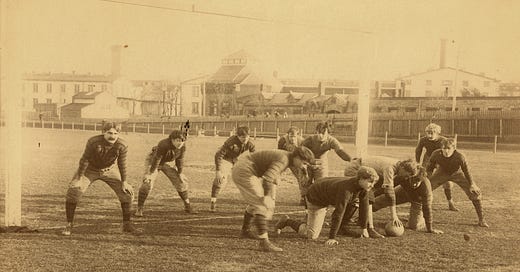Only three football rules in use today remain unchanged from those laid down by the Intercollegiate Football Association (IFA) in 1876. Every other rule was created or evolved to address specific problems or otherwise improve the game. In many cases, the concerns that led to creating a rule are no longer relevant, but the rule proved useful for other reasons and remains in effect today. Such is the case with the longstanding penalty for roughing the punter. The rule was not put in place to protect the punter during the act of punting, but to protect the punter after he punted the ball. Why would football need to protect the punter after kicking the ball? To make that connection, we must step back to understand punting and the concept of "onside" during the early days in football's history.
Early American football was rugby. The IFA rules of 1876 copied many of England's rugby rules word-for-word with only a few minor modifications of substance. As in rugby, any offensive player could punt the ball at any point in a play and from anywhere on the field, but that changed with the addition of downs and the line of scrimmage in 1880. Once offenses had three downs to make five yards, punts could occur only behind the line of scrimmage. Teams commonly punted on third down just as they do today on fourth down, but they also punted on first or second down, particularly when inside their 20-yard line. That practice remained common until the 1920s when offenses developed that allowed teams to consistently move the ball. Only then did offensive play overtake the field position and punting-oriented game that prevailed to that point.
Whereas teams have specialist punters and punt formations today, teams originally punted from the T formation. The center snapped the ball to the quarterback, who tossed it to the fullback, who then executed the punt. It was not until the late 1890s that teams snapped the ball directly to the fullback in punting situations.

Unlike today's football rules, rugby and early football rules allowed the punter's teammates to recover the punted ball, provided they were "onside" or behind him when he kicked the ball. Those teammates who were behind the punter could run downfield and recover the ball, much like occurs with onside kickoffs today. (The halfbacks were typically behind the fullback after he took several steps and punted the ball.) The punter could also run downfield and, by advancing beyond his other teammates, place them back onside, making them eligible to recover the punt. Of course, the receiving team did not want the punter running downfield, so they commonly assigned a few players to knock him down, preventing him from heading downfield. Since fullbacks generally punted the ball, the defense's tactic was known as "roughing the fullback."
Penn's coach, George Woodruff, developed the "guards back" formation in 1892 to take advantage of the offense's ability to recover the punt



